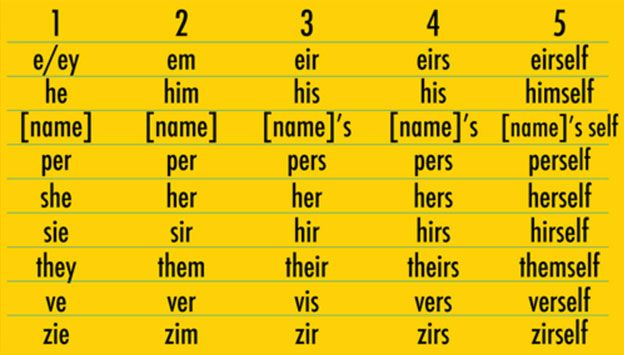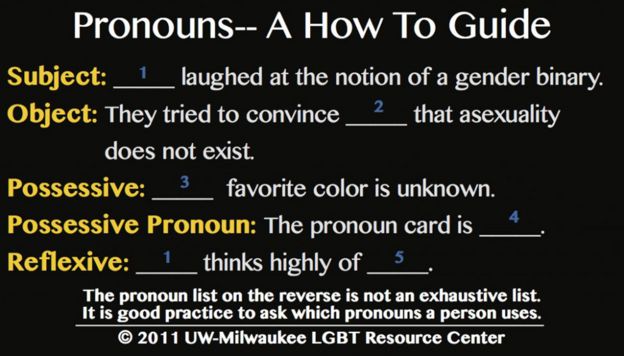LEFT WING LOONS
See other LEFT WING LOONS Articles
Title: Gender Inclusive Pronouns
Source:
Cornell University
URL Source: https://diversity.cornell.edu/netwo ... ulty/gender-inclusive-pronouns
Published: Mar 4, 2019
Author: Staff
Post Date: 2019-03-04 07:38:10 by IbJensen
Keywords: None
Views: 638
Comments: 3
Note: It is often also acceptable to use the third person plural (they, them, their, themselves) instead of the third-person singular (he/she, his/hers, him/her, himself/herself) when referring to someone who has not expressed a clear pronoun choice. Common Questions on Gender Inclusive Pronoun Usage Some people don’t feel like traditional gender pronouns (she/her, he/him) fit their gender identites. Transgender, genderqueer, and other gender- nonconforming people may choose different pronouns for themselves. The following tips are a starting point for using pronouns respectfully. How do I know which pronouns to use? If the person you’re referring to is a stranger or brief acquaintance (like a server, cashier, fellow bus patron, etc), you may not need to know. If the person is a classmate, student, or coworker, for example, it is best to ask. Try: Remember that people may change their pronouns without changing their name, appearance, or gender identity. Try making pronouns an optional part of introductions or check-ins at meetings or in class. What if I make a mistake? Most people appreciate a quick apology and correction at the time of the mistake. Try: “Her books are—I’m sorry, hir books are over there.” By correcting yourself, you’re modeling respectful pronoun use for others in the conversation. If you only realize the mistake later, a brief apology can help. Try: “I’m sorry I used the wrong pronoun earlier. I’ll be more careful next time.” When should I correct others? Some people may not want a lot of public attention to their pronouns, while others will appreciate you standing up for them. If someone uses the wrong pronoun for a person who isn’t present, try a brief correction: “I think Sam uses she and her pronouns. And yes, I’m going to her house later too!” It can be tough to remember pronouns at first. The best solution is to practice! Correct pronoun use is an easy step toward showing respect for people of every gender.
Poster Comment: America is becoming a Basketcase even considering the usage of this nonsense!


Post Comment Private Reply Ignore Thread
Top • Page Up • Full Thread • Page Down • Bottom/Latest
#1. To: All (#0)
LBGTQ perverts should be addressed as 'asshole'.
Liberals are like Slinkys. They're good for nothing, but somehow they bring a smile to your face as you shove them down the stairs.
I was in McDonalds a few months ago. There was one of those tranny fags. The guy must have been 60 or 70. He had pigtails in his hair. I started making fun of him quietly with the lady next to me in line. Then I asked the guy why he was wearing girl clothes and what was wrong with him. Then I laughed real loud at him. That is what I will do whenever I see one of those freaks. Laugh at them. Just like I do with the faggots at the casino. Yeah I was at the casino and these two faggots were talking together holding hands I think. I just looked at them and pointed at them and just burst out laughing as loud as I can. I saw them go tell one of the workers who did nothing about their complaint. Ridicule the freaks whenever you get a chance. To their face.
I like you. (in a nice way I mean)
Liberals are like Slinkys. They're good for nothing, but somehow they bring a smile to your face as you shove them down the stairs.

#2. To: IbJensen (#1)
#3. To: A K A Stone (#2)
Top • Page Up • Full Thread • Page Down • Bottom/Latest
[Home] [Headlines] [Latest Articles] [Latest Comments] [Post] [Mail] [Sign-in] [Setup] [Help] [Register]
